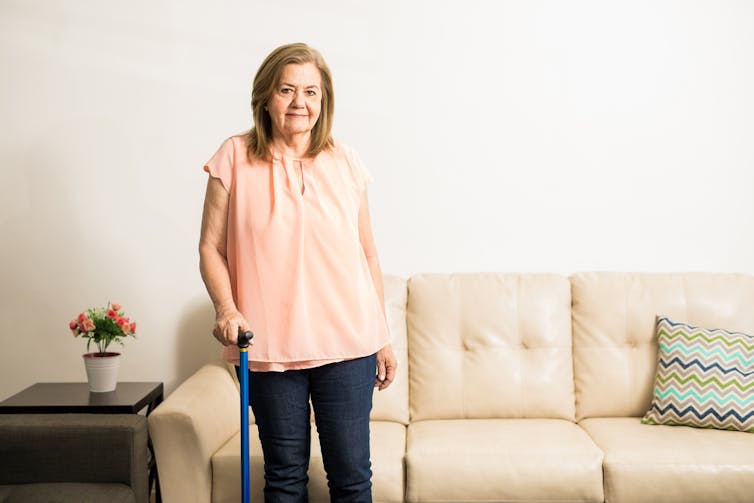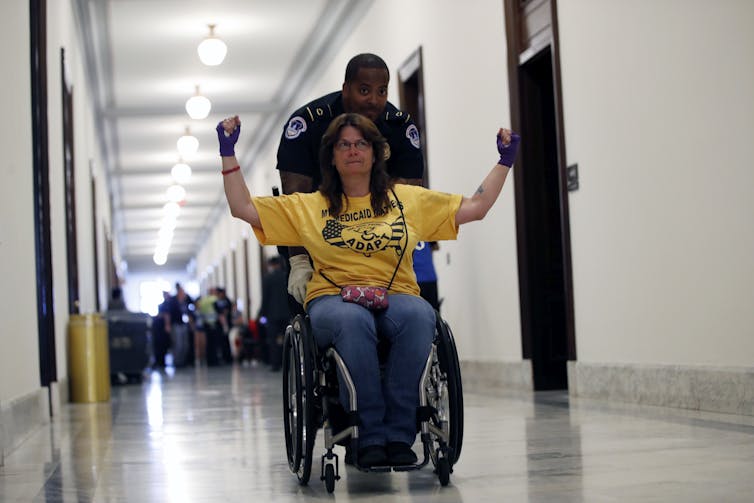Disability is often incorrectly assumed to be rare. However, global estimates suggest than one in seven adults has some form of disability.
The term “disability” covers a number of functional limitations – physical, sensory, mental and intellectual. These can range from mild to severe and might affect someone at any time across the lifespan, from an infant born with an intellectual impairment to an older adult who becomes unable to walk or see.
What is perhaps less well-known is that studies consistently show that people with disabilities are disproportionately poor. They are more likely to become poor and, when poor, are more likely to stay that way, because of barriers to getting an education, finding decent work and participating in civic life. Taken together, these barriers significantly and adversely impact their standard of living.
However, a new body of research reveals another major barrier, previously missing from most studies: People living with disabilities also face extra costs of living. Our team’s recent review of the evidence suggests that living with a disability may cost an additional several thousand dollars per year, adding up over time to be a significant financial burden on households.
Calculating the cost

Governments draw poverty lines at a level of income that they believe is sufficient to meet a minimum standard of living. Someone at the poverty line presumably has just enough resources to house, clothe and feed themselves at an acceptable level, and participate in the basic activities of being a citizen. Increasingly, countries provide cash benefits or food transfers to people below this poverty line so they are able to reach this minimum standard for basic resources.
The problem is that people with disabilities have extra costs of living that people without disabilities do not have. They have higher medical expenses and may need personal assistance or assistive devices, such as wheelchairs or hearing aids. They may need to spend more on transportation or modified housing, or be restricted in what neighborhoods they can live in to be closer to work or accessible services.
When this is the case, then some people with disabilities might appear “on paper” to live above the poverty line. But in reality, they don’t have enough money to meet the minimum standard of living captured in that poverty line.
In our recent review of the literature, we found that people with disabilities in 10 countries face large extra costs of living. These costs can range widely, from an estimated US$1,170 to $6,952 per year. In a developing country such as Vietnam, for example, the estimate stands at $595 for additional health costs alone.
We used a method called the standard of living approach, which estimates extra costs based on the gap in assets owned by households with and without disabilities. Extra costs accounted for a large share of income, from a low of 12 percent in Vietnam to 40 percent for elderly households in Ireland.
Comparing the costs of disabilities across countries is challenging. Recent studies measure what is actually spent, not what needs to be spent. Estimated costs might be less in developing countries not because it is less expensive to accommodate the needs of people with disabilities in those countries, but because the goods and services needed are not available. If wheelchairs or hearing aids are nowhere to be found, then a person cannot spend money on them.
This could lead to the paradoxical finding that, as a country starts becoming more inclusive, the measured costs of living with a disability could increase. But hopefully, at the same time, the ability of people with disabilities to work and go to school will also increase.
Unanswered questions

There is much we still don’t know about what it costs to live with a disability. In our comprehensive review of the literature, we found only 20 studies that estimated increased costs of living with a disability. The vast majority were from developed countries.
We need better information on how these extra costs may vary by type of disability, and how they may be affected by efforts to remove barriers to participation. For example, how would building a fully accessible public transportation system impact the extra transportation costs that people with disabilities face?
Our work also suggests we may need different income tests for people with disabilities when it comes to social protection programs. For example, should the income limit for receiving cash transfers or subsidized housing be higher for families with disabilities because they face these extra costs? Some countries, such as Denmark and the United Kingdom, provide benefits to support families with disabilities who bear these costs.
Another important question is whether these benefits are adequate. Do they allow people with disability and their families to reach at least a minimum threshold for standard of living? To what extent does this improve their participation in society or the economy?
Supporting people with disabilities
To address these questions, we need to monitor these issues over time. For that, we need more and better data on disability in different countries linked to good data on income, assets and expenditures. We recommend adding well-formulated disability questions to the standard household surveys currently used by most countries to chart their citizen’s wellbeing. The best example of such questions was developed under the aegis of the U.N. Statistical Commission via the Washington Group on Disability Statistics.
It’s also important to undertake qualitative research. For instance, focus groups and in-depth interviews would help researchers better understand the needs of people with disabilities in their own terms.
Policymakers also need to make social programs sensitive to the issue of extra costs associated with disability – for instance, in income tests and benefit amounts or through social health insurance programs. Our review has led us to believe that even well intended anti-poverty efforts and social protection schemes that do not take into consideration the additional costs of living with a disability will leave millions of people who have disabilities, and their families, in poverty.


